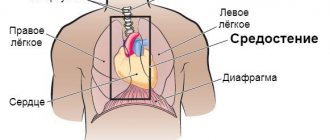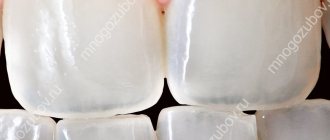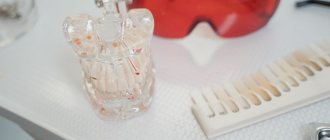Unfortunately, now a fairly small part of people can boast of a beautiful snow-white smile. An even smaller proportion do not have hidden problems and diseases of the oral cavity. Teeth deteriorate, and sometimes quite quickly. What could be the reason, and therefore how to avoid such problems? We will try to figure it out with you together.
The first thing you need to understand is how the tooth itself works. The basis of the tooth is dentin, which is covered with enamel in the crown part and in the root part with dental cement. Inside the tooth there is a cavity filled with pulp. Through the pulp, teeth receive nutrition from the blood vessels of the body. The main protection of tooth integrity is enamel. Almost entirely tooth enamel consists of mineral salts, the lack of which is one of the reasons for the onset of destruction of the integrity of the tooth. Harmful bacteria that enter the mouth through food can remain on the teeth and multiply there. If food remains between the teeth after eating, these are ideal conditions for the development of harmful bacteria. If the tooth enamel does not have enough minerals or is damaged by mechanical stress, bacteria begin to attack the dentin. This is how caries and other dental diseases appear.
Chronic diseases
The main disease is caries. If left untreated, the tooth will collapse, as the superficial lesion gradually penetrates deeper, reaching the nerve. They can also get sick and deteriorate in the presence of certain chronic diseases:
- Diabetes mellitus provokes the development of periodontitis, which causes premature tooth loss and destruction of the jaw system. In diabetes, mineral metabolism in the body is disrupted, fluoride and calcium are washed out of it, and their deficiency leads to thinning of the enamel. As a result, bacteria quickly penetrate inside the tooth, destroying it.
- Osteoporosis affects not only the spine, but also the jaw bones on which the teeth are attached. The disease develops due to a lack of calcium, which is the main element in the structure of the skeletal system. Osteoporosis destroys periodontal tissue, causing gum disease, making gums soft and exposing tooth roots where bacteria can easily penetrate.
- Hypertension, for the treatment of which drugs that cause dry mouth are often prescribed. As a result, pathogenic microorganisms are not washed off by saliva, actively multiply, penetrating microcracks in the enamel, and increase the risk of caries.
- Gastritis with high acidity, changing the qualitative composition of gastric secretions and disrupting the absorption of phosphorus and calcium from it. Their deficiency leads to a decrease in the strength of the enamel.
The curvature of the spine also has a negative impact, which can provoke improper closing of the jaws, which leads to loosening and wear of teeth. It negatively affects the condition of the oral cavity and impaired metabolism, due to which the body does not receive the required amount of vitamins and microelements.
Why do teeth deteriorate?
Reason #1 - bacteria
They are tightly attached to the surface of the tooth, accumulate, form dental plaque and secrete enzymes. As a result, organic acids are formed - pyruvic, lactic, butyric, etc. Under the dental plaque, the enamel becomes softer, and then a defect forms on it. Moreover, the superficial layers of enamel are damaged less than the deep ones. At first glance it looks like minor damage. In fact, half of the tooth is already missing inside.
Reason #2 - pH
The more acidic the environment in the mouth, the more comfortable it is for bacteria. An acidic environment is the result of eating habits. Do you like sweets, baked goods, soda? Can't imagine yourself without smoked sausage? Are vegetables and herbs rare “guests” on your table? This is fraught with chronic acidosis - “acidification” of the body. And this is a direct path to caries. As well as chronic fatigue, osteoporosis and other “diseases of civilization.”
Poor nutrition
Proper nutrition affects both the entire body as a whole and its individual systems, including preventing the development of dental diseases. The most dangerous is the unreasonable consumption of carbohydrates, namely sugar-containing products, and their significant predominance in the diet.
To maintain dental health, it is recommended to include foods rich in:
- protein (meat, fish, eggs, milk), since its deficiency has an unsatisfactory effect on the accumulation of calcium;
- fluoride (seafood, fish, buckwheat, radishes, carrots), the optimal amount of which increases the resistance of tooth enamel to pathological factors;
- calcium (cabbage, nuts, fruits, dairy products), which has a positive effect on the crystal lattice of teeth.
In order to avoid negative effects on the jaw system, you should limit the consumption of sticky, viscous foods - toffee, chocolate bars, liquid caramel.
Such food sticks to the teeth, is poorly washed off by saliva, and contributes to the development of caries. You should not abuse sweet carbonated drinks and packaged juices, due to the high sugar content in them.
When is a person to blame for having bad teeth?
Experts identify a number of causes of tooth decay, for which the patient himself is to blame. Knowing them, you can take timely measures to prevent the development of the disease. These reasons include:
- Smoking. Components released from tobacco disrupt metabolic processes in dental tissues. Due to this, their ability to resist adverse effects is sharply reduced.
- Alcohol, drugs. They negatively affect the functioning of the entire body, impair its protective functions and ability to recover.
- Poor nutrition. Lack of minerals and vitamins in food leads to weakening of the enamel. An excess of sweets, sour fruits, and berries contributes to the destruction of enamel.
- Unhealthy Lifestyle. Lack of physical activity, constant presence in dusty rooms, abuse of fatty, fried foods reduces the body's protective functions.
In addition, lack of or improper oral hygiene contributes to the formation of plaque. It becomes a source of food for microorganisms that gradually destroy teeth.
Improper hygiene
To maintain dental health, daily oral hygiene is necessary. The main thing that is taught from early childhood is to clean them twice a day, morning and evening, preferably after eating for at least 3 minutes.
In addition, proper hygiene includes:
- optimal selection of toothbrush and toothpaste, depending on the condition of the gums and teeth;
- replacing the old brush with a new one at least once every three months;
- cleansing the tongue and cheeks.
People who maintain proper hygiene are less likely to develop gingivitis and periodontal disease.
In addition to a toothbrush and paste, it is recommended to use special rinses and floss, the diameter of which is selected depending on the distance between the teeth, to clean the oral cavity. You should not use one paste for more than 3 months to avoid addiction.
Stages of dental caries
Initial stage of caries
There are several stages of caries. However, there is no clear boundary between them, and each stage smoothly flows into the next.
The easiest one is caries in the form of a carious spot. At this stage, a barely noticeable stain appears on the tooth enamel. It can be either chalky (white) or pigmented (black or brown). In this case, the person will not experience any painful sensations. Because of this, many people attribute the appearance of stains to plaque and do not consult a doctor, coming to the dental office only after pain appears.
Caries at this stage is quite difficult to diagnose even for an experienced dentist. Therefore, a special aqueous solution of methylene blue is often used to determine the disease. At this stage, it is still possible to stop the process of tooth decay and restore tooth enamel.
If caries is detected at an early stage, then it is quite possible that remineralizing procedures can correct the situation. The damaged tooth surface is treated with fluoride-containing toothpaste and applications of a solution of sodium fluoride and calcium gluconate are applied to it. In some cases, the dentist may apply these solutions using electrophoresis.
In addition, they recommend:
- taking vitamins;
- taking phosphorus and calcium supplements;
- using dental floss and special toothpastes;
- regular visits to the dentist;
- a special diet that includes foods with calcium and proteins;
- careful oral hygiene.
The second stage of caries – superficial caries
At this stage, changes are visually visible on the tooth. There is no pain yet, but there is already a reaction of the tooth to hot or cold food or drinks.
Moreover, caries at this stage affects only the surface of the tooth, without penetrating into its tissues. It often happens that it “hides” between the teeth, is present on the oral side of the dentition, so it is difficult to notice it yourself.
In some cases, at this stage of the disease, small brown or black spots, yellow or white plaque, and enamel defects may be observed on the patient's teeth. At this stage, remineralizing procedures alone are no longer sufficient; treatment in a dental clinic is required.
The simplest treatment method is tooth filling. The dentist uses a bur to remove the infected tooth tissue, treat the cavity and install a filling.
Third stage – medium caries
If you ignore the beginning symptoms, then superficial caries will develop into medium caries and affect not only the tooth enamel, but also the inner layer of the tooth - dentin. At this stage, a carious cavity has already formed in the tooth, it begins to hurt, reacts to hot and cold, including cold air when talking, and food can get stuck in it. Visually, dark spots or small cracks will be noticeable on the diseased tooth.
The dentist selects treatment depending on the extent of the carious lesion and the condition of the tooth. Most often, the carious cavity is prepared, the affected dental tissue is removed, and the tooth is filled. These actions are usually performed under anesthesia, as the patient may experience pain.
Stage four – deep caries
At the fourth stage, it is simply impossible not to notice caries on a tooth. The area affected by dark spots increases, and the person begins to feel not short-term, but long-term pain while eating, talking in cold air, and even for no apparent reason.
The sequence of treatment for deep caries is determined by the doctor. As a rule, this happens in two visits to the dental clinic. On the first visit, it is recommended to remove all tissues affected by caries, apply medicinal substances and cover the tooth with a temporary filling. If the tooth does not start to hurt, then at the next visit the temporary filling is replaced with a permanent one. It is worth noting that such stages of caries are identified only in Russia. In America and Europe, dentists distinguish: enamel caries (superficial caries), caries of soft dental tissues and cement caries.
Regardless of the names, photos of the stages of caries clearly demonstrate how the disease gradually progresses and tooth decay occurs.
Genetic predisposition
The quality of teeth depends on what kind of teeth the parents had. Dental heredity can manifest itself both in children, during the formation of teeth, and in adults. It is not the specific disease that depends on genes, but the predisposition to it.
Heredity affects:
- tooth structure;
- jaw shape;
- metabolism in the body, which influences the occurrence of caries.
Studies have shown that if both parents had the first manifestations of caries on their lower teeth, then the same row will be weaker in the child. Scientists also found that if mothers had bad teeth, then 90% of children subsequently developed various dental diseases.
Dental care if teeth begin to crumble.
The dentist will select the appropriate method for restoring the integrity and natural appearance of the tooth. The choice largely depends on the degree of its defeat.
Mineralization
A strengthening procedure during which applications containing calcium and fluoride are applied to damaged teeth.
Fluoride coating of teeth
The procedure also strengthens the enamel, but special fluoride-containing pastes are used.
Sealing
If a tooth is slightly crumbled, it can be restored using filling material.
Veneers
Used if the front tooth has crumbled. Ceramic onlays will perfectly restore the beauty of your smile.
Tabs
When the chewing tooth is destroyed by 50%, reliable inlays are saved. They are more durable and airtight than fillings.
Crowns
If the tooth is left with virtually no crown part, prosthetics should be performed with ceramic crowns - excellent for front teeth, and zirconium - for chewing teeth.
Removal followed by implantation
When a tooth has crumbled and only the destroyed root remains, it must be removed and, if possible, an implant and crown should be immediately installed on it.
Lifestyle and micronutrient deficiencies
To a certain extent, a person’s lifestyle affects the condition of their teeth. Thus, in people involved in certain sports (boxing, hockey), they are often injured, their integrity is compromised, a crack forms, and a crown or root fracture occurs. Because of this, the tooth becomes loose and its position in relation to the rest of the jaw changes.
A lack of vitamins and microelements causes hypovitaminosis, which is manifested by bleeding gums during the cleaning process. Most often, this happens in the winter-spring period, due to a lack of fresh fruits and vegetables.
To eliminate vitamin deficiency, you should take synthetic preparations that contain the required amount of all trace elements and minerals.
Malocclusion
Malocclusion is diagnosed in the majority of the population. But, people go to the clinic for its correction only in case of a pronounced anomaly, although due to malocclusion the following occurs:
- Uneven load on teeth when chewing food. For some of them it is double the amount, while others are inactive. Due to excessive pressure, dental tissue is destroyed, leading to tooth loss.
- Reduced chewing activity, since not every tooth can participate in the process. To chew food well, you need to close your jaws tightly, but if you want to do this, discomfort and pain often occur. As a result, the composition of bone and soft tissue is disrupted.
An incorrect bite provokes the occurrence of an inflammatory process in the gums - periodontitis. In some people, due to an abnormal bite, involuntary grinding of teeth occurs - bruxism, which causes tooth wear and loosening.
Causes of tooth decay. How to stop him?
To provide adequate treatment, the doctor must first determine the cause of the disease. Otherwise, the measures may turn out to be useless, the process will continue to develop. The causes of tooth decay are external and internal factors. Despite the fact that enamel is considered one of the most durable materials in the body, under unfavorable conditions it quickly deteriorates. As a result, microbes gain unhindered access to the inner, less protected part of the tooth.
To cope with this problem at the initial stage, one visit to the dentist is usually enough. He clears the cavity of affected tissue and closes it with a filling. However, simple neglect of their health and fear of the dental office make people postpone the visit. The result is deterioration of the teeth and their loss.
Bad habits
Bad habits have an important impact on the condition of the oral cavity. These include:
- Drinking alcohol and smoking. Alcohol and nicotine contained in drinks and cigarettes change the composition of saliva, increasing the acid content. This negatively affects the composition of tooth enamel, and pores form in hard tissues.
- Chewing laziness. Dentists use a similar term to describe reluctance to eat solid foods that require thorough chewing. As a result, there are no processes of self-cleaning of the oral cavity; dental plaque accumulates in large quantities, causing caries and damage to periodontal tissue.
The habit of constantly gnawing nuts and seeds, opening the lids of cans and bottles with your teeth, and using toothpicks also negatively affects the condition of your teeth and provokes their damage.
Maintaining oral hygiene, a balanced diet, including raw vegetables and fruits, enriched with essential vitamins and microelements, will have a beneficial effect on the condition of teeth and gums.
You should also minimize the consumption of sweet drinks and sugar-containing foods and get rid of bad habits. But, first of all, even excluding all the negative aspects, it is necessary to regularly (at least once a year) undergo a preventive examination with a dentist.










